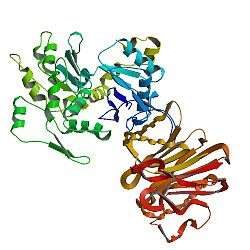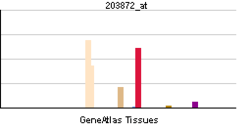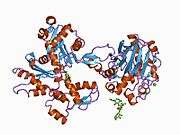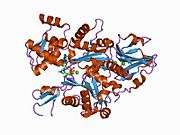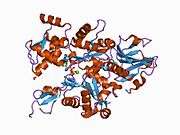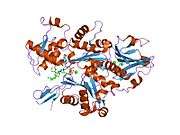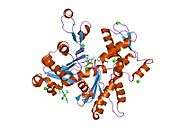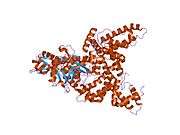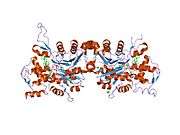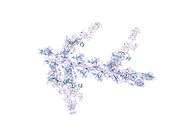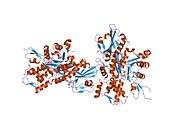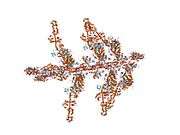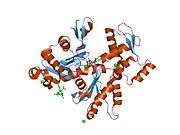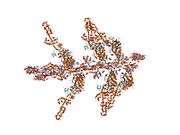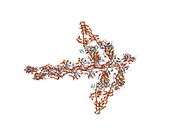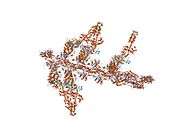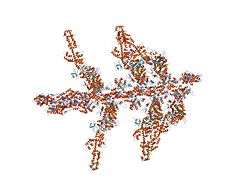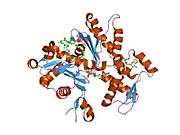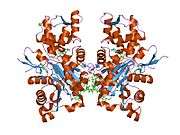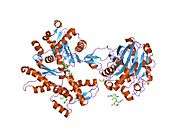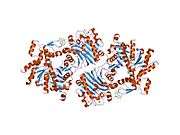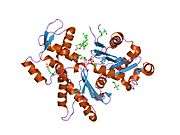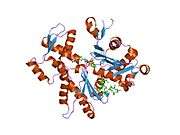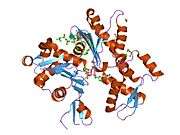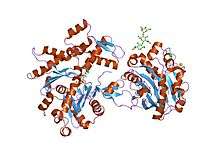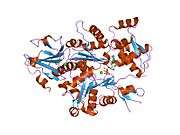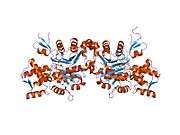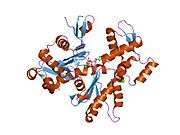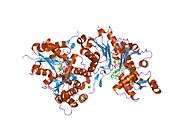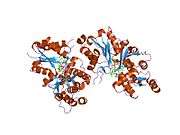Actin, alpha 1
Actin, alpha skeletal muscle is a protein that in humans is encoded by the ACTA1 gene.[1][2]
Actin alpha 1 which is expressed in skeletal muscle is one of six different actin isoforms which have been identified. Actins are highly conserved proteins that are involved in cell motility, structure and integrity. Alpha actins are a major constituent of the contractile apparatus.[3]
Skeletal actin gene expression
Skeletal alpha actin expression is induced by stimuli and conditions known to cause muscle formation.[4] Such conditions result in fusion of committed cells (satellite cells) into myotubes, to form muscle fibers. Skeletal actin itself, when expressed, causes expression of several other "myogenic genes", which are essential to muscle formation.[5] One key transcription factor that activates skeletal actin gene expression is Serum Response Factor ("SRF"), a protein that binds to specific sites on the promoter DNA of the actin gene.[6] SRF may bring a number of other proteins to the promoter of skeletal actin, such as andogen receptor, and thereby contribute to induction of skeletal actin gene expression by androgenic (often termed "anabolic") steroids.[7]
Interactions
Actin, alpha 1 has been shown to interact with TMSB4X,[8][9] MIB2[10] and PRKCE.[11]
See also
References
- ↑ Mogensen J, Kruse TA, Borglum (March 1999). "Assignment of the human skeletal muscle [FC12]a-actin gene (ACTA1) to chromosome 1q42.13-->q42.2 by radiation hybrid mapping". Cytogenet Cell Genet 83 (3-4): 224–5. doi:10.1159/000015184. PMID 10072583.
- ↑ Gunning P, Ponte P, Okayama H, Engel J, Blau H, Kedes L (August 1983). "Isolation and characterization of full-length cDNA clones for human alpha-, beta-, and gamma-actin mRNAs: skeletal but not cytoplasmic actins have an amino-terminal cysteine that is subsequently removed". Mol Cell Biol 3 (5): 787–95. doi:10.1128/mcb.3.5.787. PMC 368601. PMID 6865942.
- ↑ "Entrez Gene: ACTA1 actin, alpha 1, skeletal muscle".
- ↑ Bandman, E (1992). "Contractile protein isoforms in muscle development.". Developmental Biology 154 (2): 273–83. doi:10.1016/0012-1606(92)90067-Q. PMID 1358730.
- ↑ Gunning, PW; Ferguson, V; Brennan, KJ; Hardeman, EC (2001). "Alpha-skeletal actin induces a subset of muscle genes independently of muscle differentiation and withdrawal from the cell cycle.". Journal of Cell Science 114 (Pt 3): 513–24. PMID 11171321.
- ↑ Belaguli, NS; Zhou, W; Trinh, TH; Majesky, MW; Schwartz, RJ (1999). "Dominant negative murine serum response factor: alternative splicing within the activation domain inhibits transactivation of serum response factor binding targets.". Molecular and Cellular Biology 19 (7): 4582–91. PMC 84256. PMID 10373507.
- ↑ Vlahopoulos, S; Zimmer, WE; Jenster, G; Belaguli, NS; Balk, SP; Brinkmann, AO; Lanz, RB; Zoumpourlis, VC; Schwartz, RJ (2005). "Recruitment of the androgen receptor via serum response factor facilitates expression of a myogenic gene.". The Journal of Biological Chemistry 280 (9): 7786–92. doi:10.1074/jbc.M413992200. PMID 15623502.
- ↑ Ballweber, Edda; Hannappel Ewald; Huff Thomas; Stephan Harald; Haener Markus; Taschner Nicole; Stoffler Daniel; Aebi Ueli; Mannherz Hans Georg (January 2002). "Polymerisation of chemically cross-linked actin:thymosin beta(4) complex to filamentous actin: alteration in helical parameters and visualisation of thymosin beta(4) binding on F-actin". J. Mol. Biol. (England) 315 (4): 613–25. doi:10.1006/jmbi.2001.5281. ISSN 0022-2836. PMID 11812134.
- ↑ Safer, D; Sosnick T R; Elzinga M (May 1997). "Thymosin beta 4 binds actin in an extended conformation and contacts both the barbed and pointed ends". Biochemistry (UNITED STATES) 36 (19): 5806–16. doi:10.1021/bi970185v. ISSN 0006-2960. PMID 9153421.
- ↑ Takeuchi, Tamotsu; Heng Henry H Q; Ye Christine J; Liang Sheng-Ben; Iwata Jun; Sonobe Hiroshi; Ohtsuki Yuji (October 2003). "Down-regulation of a novel actin-binding molecule, skeletrophin, in malignant melanoma". Am. J. Pathol. (United States) 163 (4): 1395–404. doi:10.1016/S0002-9440(10)63497-9. ISSN 0002-9440. PMC 1868282. PMID 14507647.
- ↑ England, Karen; Ashford David; Kidd Daniel; Rumsby Martin (June 2002). "PKC epsilon is associated with myosin IIA and actin in fibroblasts". Cell. Signal. (England) 14 (6): 529–36. doi:10.1016/S0898-6568(01)00277-7. ISSN 0898-6568. PMID 11897493.
External links
Further reading
- Snásel J, Pichová I (1997). "The cleavage of host cell proteins by HIV-1 protease.". Folia Biol. (Praha) 42 (5): 227–30. doi:10.1007/BF02818986. PMID 8997639.
- Di Fiore PP, Scita G (2002). "Eps8 in the midst of GTPases.". Int. J. Biochem. Cell Biol. 34 (10): 1178–83. doi:10.1016/S1357-2725(02)00064-X. PMID 12127568.
- Ogawa H, Shiraki H, Matsuda Y, Nakagawa H (1978). "Interaction of adenylosuccinate synthetase with F-actin.". Eur. J. Biochem. 85 (2): 331–7. doi:10.1111/j.1432-1033.1978.tb12243.x. PMID 648524.
- den Hartigh JC, van Bergen en Henegouwen PM, Verkleij AJ, Boonstra J (1992). "The EGF receptor is an actin-binding protein.". J. Cell Biol. 119 (2): 349–55. doi:10.1083/jcb.119.2.349. PMC 2289650. PMID 1383230.
- Adams LD, Tomasselli AG, Robbins P; et al. (1992). "HIV-1 protease cleaves actin during acute infection of human T-lymphocytes.". AIDS Res. Hum. Retroviruses 8 (2): 291–5. doi:10.1089/aid.1992.8.291. PMID 1540415.
- Levine BA, Moir AJ, Patchell VB, Perry SV (1992). "Binding sites involved in the interaction of actin with the N-terminal region of dystrophin.". FEBS Lett. 298 (1): 44–8. doi:10.1016/0014-5793(92)80019-D. PMID 1544421.
- Rijken PJ, Hage WJ, van Bergen en Henegouwen PM; et al. (1992). "Epidermal growth factor induces rapid reorganization of the actin microfilament system in human A431 cells.". J. Cell. Sci. 100 (3): 491–9. PMID 1808202.
- Tomasselli AG, Hui JO, Adams L; et al. (1991). "Actin, troponin C, Alzheimer amyloid precursor protein and pro-interleukin 1 beta as substrates of the protease from human immunodeficiency virus.". J. Biol. Chem. 266 (22): 14548–53. PMID 1907279.
- Shoeman RL, Kesselmier C, Mothes E; et al. (1991). "Non-viral cellular substrates for human immunodeficiency virus type 1 protease.". FEBS Lett. 278 (2): 199–203. doi:10.1016/0014-5793(91)80116-K. PMID 1991513.
- Winder SJ, Walsh MP (1990). "Smooth muscle calponin. Inhibition of actomyosin MgATPase and regulation by phosphorylation.". J. Biol. Chem. 265 (17): 10148–55. PMID 2161834.
- Kabsch W, Mannherz HG, Suck D; et al. (1990). "Atomic structure of the actin:DNase I complex.". Nature 347 (6288): 37–44. doi:10.1038/347037a0. PMID 2395459.
- Takahashi K, Hiwada K, Kokubu T (1988). "Vascular smooth muscle calponin. A novel troponin T-like protein.". Hypertension 11 (6 Pt 2): 620–6. doi:10.1161/01.hyp.11.6.620. PMID 2455687.
- Taylor A, Erba HP, Muscat GE, Kedes L (1989). "Nucleotide sequence and expression of the human skeletal alpha-actin gene: evolution of functional regulatory domains.". Genomics 3 (4): 323–36. doi:10.1016/0888-7543(88)90123-1. PMID 2907503.
- Shen BW, Josephs R, Steck TL (1986). "Ultrastructure of the intact skeleton of the human erythrocyte membrane.". J. Cell Biol. 102 (3): 997–1006. doi:10.1083/jcb.102.3.997. PMC 2114132. PMID 2936753.
- Burgess DR, Broschat KO, Hayden JM (1987). "Tropomyosin distinguishes between the two actin-binding sites of villin and affects actin-binding properties of other brush border proteins.". J. Cell Biol. 104 (1): 29–40. doi:10.1083/jcb.104.1.29. PMC 2117036. PMID 3793760.
- Kedes L, Ng SY, Lin CS; et al. (1986). "The human beta-actin multigene family.". Trans. Assoc. Am. Physicians 98: 42–6. PMID 3842206.
- Hanauer A, Levin M, Heilig R; et al. (1983). "Isolation and characterization of cDNA clones for human skeletal muscle alpha actin.". Nucleic Acids Res. 11 (11): 3503–16. doi:10.1093/nar/11.11.3503. PMC 325982. PMID 6190133.
- Bretscher A, Weber K (1980). "Villin is a major protein of the microvillus cytoskeleton which binds both G and F actin in a calcium-dependent manner.". Cell 20 (3): 839–47. doi:10.1016/0092-8674(80)90330-X. PMID 6893424.
| |||||||||||||||||||||||||||||||||||||||||||||||||||||||||||||||||||||||||||||||||||||||||||||||||||||||||||||||||||||||||||||||||||||
| ||||||||||||||||||||||||||||||||||||||||||||||||||||||||||||||||||||||||||||||||||||||||||
